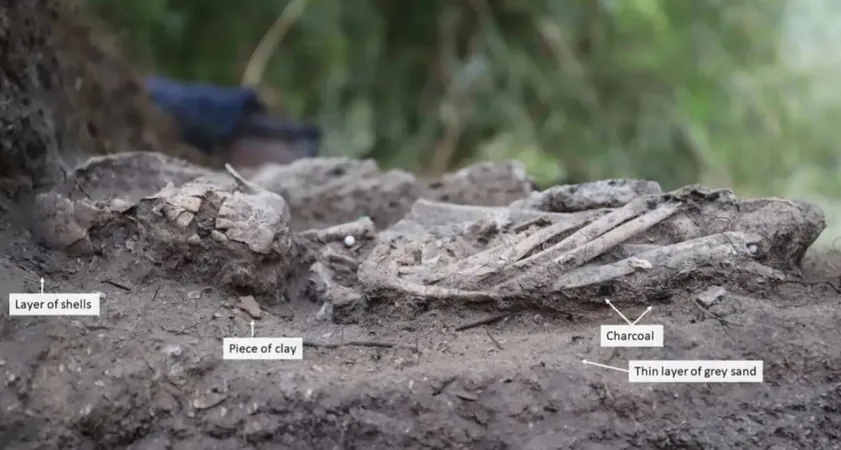
Unearthing the Secrets of Ancient Child Burials: Insights into Mesolithic Funerary Practices
2025-09-09
Author: Yu
Unlocking the Mysteries of Cabeço da Amoreira
A groundbreaking study led by Dany Coutinho-Nogueira reveals fascinating details about child burials from Cabeço da Amoreira, a pivotal Mesolithic site located in the Iberian Peninsula. This research, recently published in the journal *Childhood in the Past*, sheds light on the funerary practices of the last hunter-gatherers in Western Europe.
A Historical Haven for Hunter-Gatherers
Dating back to around 8000–7100 years before present (cal BP), Cabeço da Amoreira was a vital settlement for hunter-gatherers following the significant 8.2 climatic event. As coastal sites dwindled, communities thrived along the rich estuaries of the Tagus and Sado rivers, seizing the abundance of fish and shellfish, according to Coutinho-Nogueira.
The Changing Landscape: From Hunter-Gatherers to Farmers
This era of Mesolithic occupation met its end approximately 7100 BP, coinciding with a decreased salinity in local waters that diminished aquatic resources. This transition period also marked the arrival of Neolithic farmers and pastoralists, whose presence is evidenced by ceramics discovered at Cabeço da Amoreira. The intriguing dynamics of population replacement and cultural exchange during this transition continue to fuel academic inquiry.
Digging Deeper: The Past Comes Alive
Excavations at Cabeço da Amoreira have been ongoing since its discovery in 1864, with renewed efforts under Nuno Bicho and Célia Gonçalves since 2008. Their work has unearthed a continuous human presence at the site, extending from 8000 to 7400 cal BP, and unearthed multiple burial sites, including three poignant non-adult interments.
The Young Spirits: What the Burials Reveal
Among the three children examined were CAM-2019-5, CAM 2022-6, and CAM 2023-7. Each burial exhibited unique characteristics correlating with varied mortuary practices. Notably, CAM 2022-6, a perinatal individual, lacked burial features or grave goods, hinting at the profound cultural significance surrounding newborn deaths at the time.
In contrast, CAM 2019-5, estimated to have died between 7.5 and 11.5 years old, was delicately placed on its back, possibly wrapped in perishable materials that have since disintegrated. The discovery of a single lithic tool and a perforated shell near the burial site hints at ritual significance.
A Unique Grave: The Case of CAM 2023-7
CAM 2023-7 stands distinct from the others, buried amidst a complex structure crafted from clay layers and adorned with shells and faunal remains. Coutinho-Nogueira notes only one other burial site shows such intricacy—which raises questions about the social customs surrounding child burials.
The Quest for Understanding: Future Investigations
Despite similarities in the flexed positions of both adult and child interments, variations in body and artifact positioning suggest a rich tapestry of cultural practices at play. Coutinho-Nogueira emphasizes the need for further research, including precise dating, dietary studies, and DNA analyses to unravel the nuanced relationships among these ancient individuals.
As these investigations advance, they are poised to deepen our understanding of the complex social dynamics and cultural traditions of Mesolithic communities.



 Brasil (PT)
Brasil (PT)
 Canada (EN)
Canada (EN)
 Chile (ES)
Chile (ES)
 Česko (CS)
Česko (CS)
 대한민국 (KO)
대한민국 (KO)
 España (ES)
España (ES)
 France (FR)
France (FR)
 Hong Kong (EN)
Hong Kong (EN)
 Italia (IT)
Italia (IT)
 日本 (JA)
日本 (JA)
 Magyarország (HU)
Magyarország (HU)
 Norge (NO)
Norge (NO)
 Polska (PL)
Polska (PL)
 Schweiz (DE)
Schweiz (DE)
 Singapore (EN)
Singapore (EN)
 Sverige (SV)
Sverige (SV)
 Suomi (FI)
Suomi (FI)
 Türkiye (TR)
Türkiye (TR)
 الإمارات العربية المتحدة (AR)
الإمارات العربية المتحدة (AR)